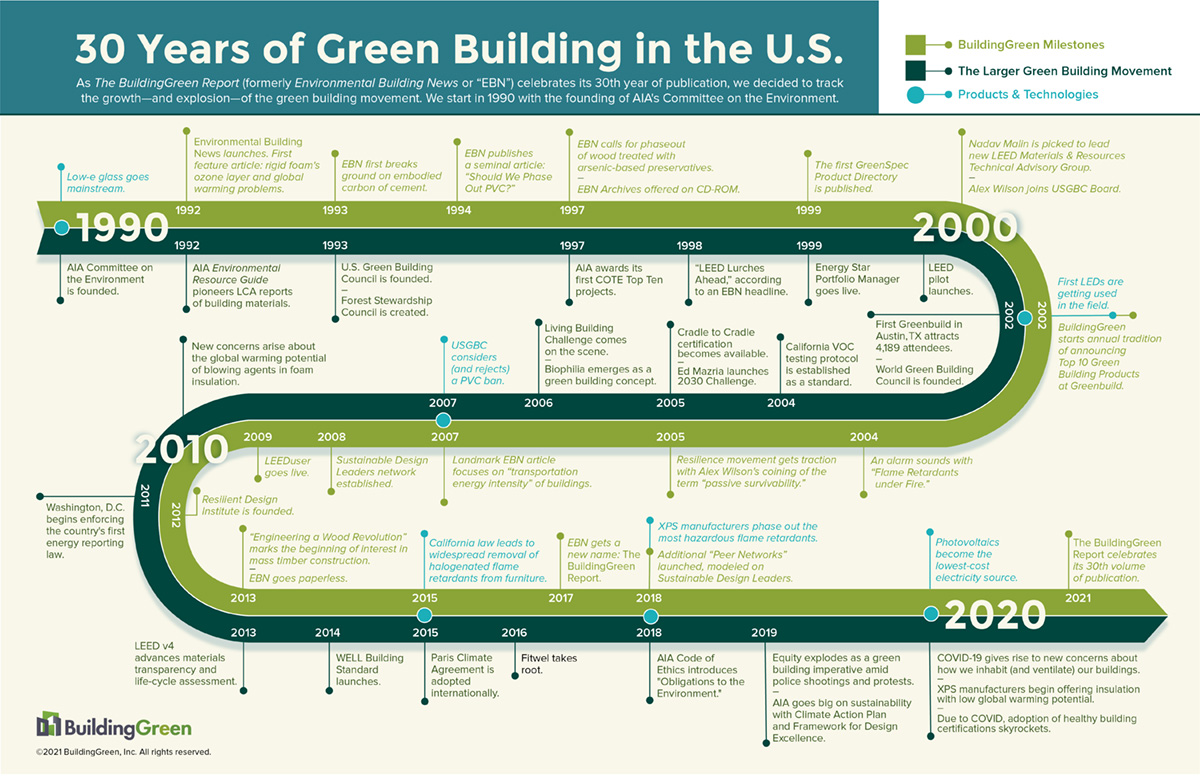Blog Post
Celebrating 30 Years of Publication
It has been quite a wild ride! As The BuildingGreen Report (formerly Environmental Building News) celebrates its 30th year of publication, we decided to track the growth—and explosion—of the green building movement. We start in 1990 with the founding of AIA’s Committee on the Environment.

Our Editors’ Picks
To celebrate Volume 30 of BuildingGreen's publication this blog features a few of our editors’ favorite pieces.
Rethinking the All-Glass Building
Selected by Paula Melton, Editorial Director
This report details, by the numbers, why all-glass facades are bad for the environment and for building occupants—and it’s still relevant today because our love affair with glass hasn’t yet ended.
“Is it time to end our love affair with the all-glass building? A lot of proponents of high-performance, green design certainly think so—while other respected architects, including some leading green designers and energy experts, argue that all-glass can work well if done right.”
SUPPORT INDEPENDENT SUSTAINABILITY REPORTING
BuildingGreen relies on our premium members, not on advertisers. Help make our work possible.
See membership options »Avoiding the Global Warming Impact of Insulation
Selected by Brent Ehrlich, Products Specialist
Though controversial, this article redefined how we view the global warming potential (GWP) of our insulation choices. This issue has become more prescient as our climate crisis has grown and manufacturers are now struggling (finally) to move to low-GWP alternatives.
“While all insulation materials reduce greenhouse gas emissions (by saving energy), insulating with thick layers of extruded polystyrene or spray polyurethane foam insulation results in very long ‘payback periods’ for the global warming potential of the insulation, thwarting even the best attempts to create carbon-neutral buildings.”
The Four Core Issues to Tackle for Resilient Design (And the Programs That Can Help)
Selected by Candace Pearson, Senior Research Analyst
It feels urgent for our industry to tackle resilient design, and yet I think the concept is still amorphous for a lot of practitioners. I remember struggling with that for this feature from 2016. I ended up finding some reassurance in the frameworks that had been created, but also a lot of room for creative problem solving if one understood the basic questions to ask.
“Hurricanes, tsunamis, wildfires, and other disasters have drawn attention to resilient design mostly by showing us what not to do in the built environment. We’ve come a long way in a short time, and today we’re on the cusp of having metrics and rating systems that clearly define what we should do—how to design buildings that can withstand natural disasters and even remain functional during and after disruptions.”
The Mindset Thing: Exploring the Deeper Potential of Integrated Design
Selected by Nadav Malin, President
This feature pointed out the real challenge to getting better designs and better technologies adopted on projects, and provided some examples of how industry leaders have worked to shift that barrier.
“The inertia of the building industry and the tendency to fall back into doing things the way they’ve been done in the past makes it challenging to introduce new technologies and design solutions. When a client and design team are operating within their usual set of assumptions and relationships, they frequently abandon green measures in the face of schedule, budgetary constraints, or contrary participants in the project. If the project team has adopted a mindset that casts conventional solutions as unacceptable, however, backsliding is much less likely.”
Driving to Green Buildings: The Transportation Energy Intensity of Buildings
Selected by Alex Wilson, Founder
Originally published in 2007 and updated with Paula Melton’s help in 2018 — Alex's article was seminal in raising awareness about the role that building location plays in transportation sector climate and health impacts.
“It’s time for the green building community to embrace the transportation energy intensity of our buildings much more directly. Where we build should be given greater attention, and our tools for evaluating building performance should include metrics that relate to transportation.”
Published February 25, 2021 Permalink Citation
editors, t. (2021, February 25). Celebrating 30 Years of Publication. Retrieved from https://www.buildinggreen.com/blog/celebrating-30-years-publication



Add new comment
To post a comment, you need to register for a BuildingGreen Basic membership (free) or login to your existing profile.